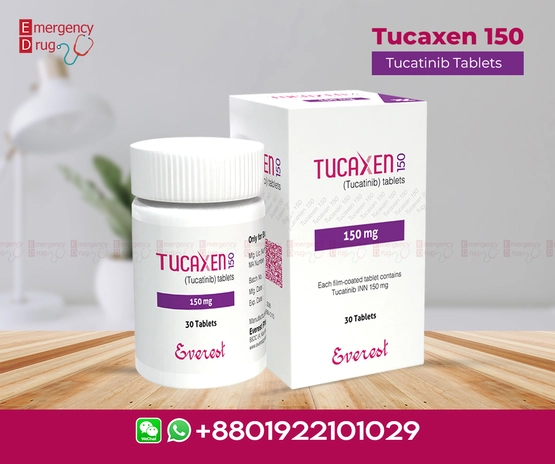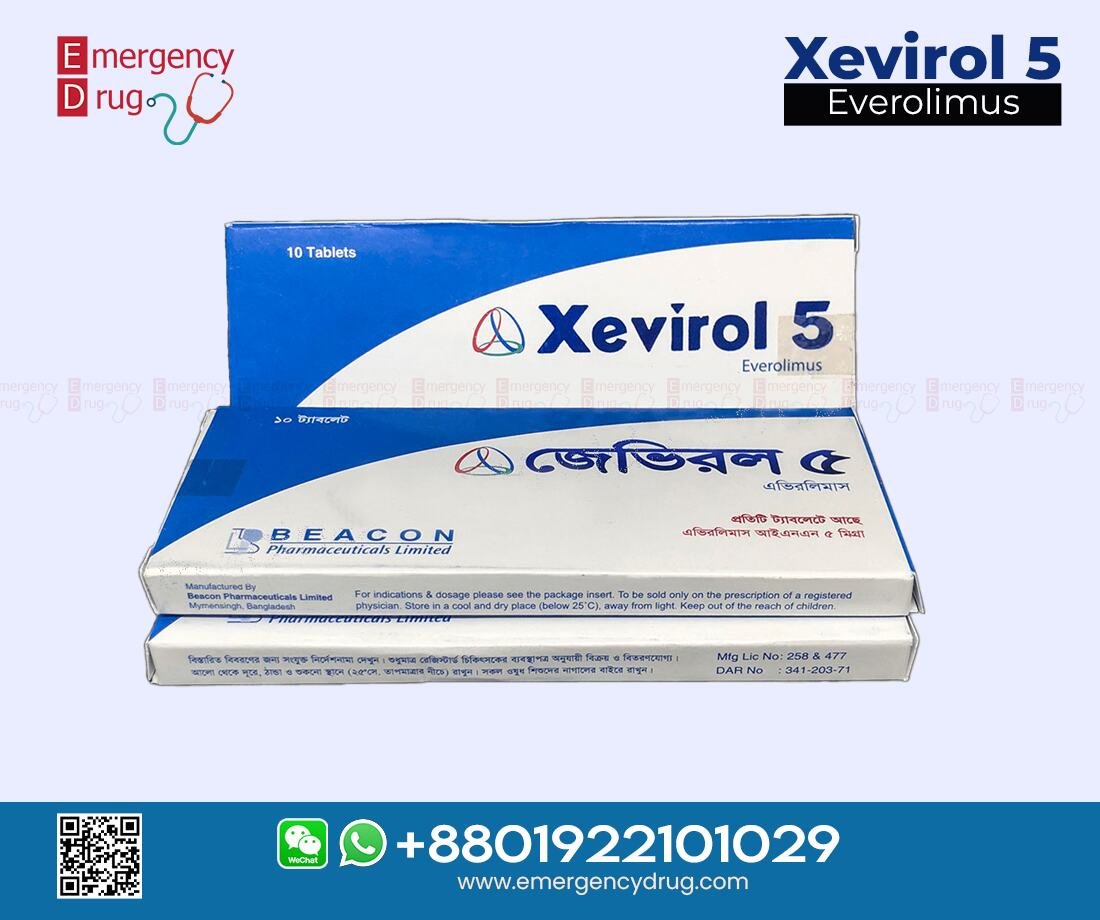Description
Features of Tab Tucaxen 150 mg
Product Name: Tucaxen
Generic Name: Tucatinib
Formulation: Tablets
Available Pack Size: 30’s in a bottle
Available Strengths: 150 mg
Manufacturer: Everest Pharmaceuticals Ltd.
Tucaxen Price: $550.00
Indications of Tucaxen
Tab Tucaxen is combined with trastuzumab and capecitabine to treat adult patients with advanced unrespectable or metastatic HER2-positive breast cancer, including patients with brain metastases who have received one or more prior anti-HER2-based regimens in the metastatic setting.
Tablet Tucaxen 150 Mg (Tucatinib), generic Tukysa, is used with trastuzumab (Herceptin) and capecitabine (Xeloda) to treat a certain type of hormone receptor-positive breast cancer that has spread to other parts of the body and cannot be treated with surgery in adults who have already been treated with at least one other chemotherapy medication. Tucatinib is in a class of drugs called kinase inhibitors. It works by blocking the action of the abnormal protein that signals cancer cells to multiply. This helps stop or slow the spread of cancer cells.
Composition
Tucaxen 50 Tablet: Each film-coated tablet contains Tucatinib INN 50 mg.
Tucaxen 150 Tablet: Each film-coated tablet contains Tucatinib INN 150 mg.
Pharmacology
Mechanism of Action
Tucatinib is a tyrosine kinase inhibitor of HER2. In vitro, it inhibits phosphorylation of HER2 and HER3, resulting in inhibition of downstream MAPK and AKT signaling and cell proliferation, and showed anti-tumor activity in HER2 expressing tumor cells. In vivo, it inhibited the growth of HER2 expressing tumors. The combination of Tucatinib and trastuzumab showed increased anti-tumor activity in vitro and in vivo compared to either drug alone.
Pharmacodynamics
Exposure Response Relationship: Tucaxen exposure-response relationships and the time course of pharmacodynamics response have not been fully characterized.
Cardiac Electrophysiology: No large mean increase in QTc (i.e., > 20 ms) was detected following treatment at the recommended dose of 300 mg taken orally twice daily.
Pharmacokinetics: Tucatinib AUCO-INF and Cmax increase proportionally over a dosage range from 50 mg to 300 mg (0.17 to 1 times the approved recommended dosage). Tucatinib exhibited 1.7-fold accumulation for AUC and 1.5-fold accumulation for Cmax after administering Tucatinib 300 mg twice daily for 14 days. The time to steady state was approximately 4 days.
Absorption: The median time to peak plasma concentration of Tucaxen was approximately 2 hours (range 1 to 4 hours).
Effects of Food:
- After administering a single oral dose of Tucatinib to 11 subjects after a high-fat meal (approximately 58% fat, 26% carbohydrate, and 16% protein), the mean AUCO-INF increased by 1.5-fold.
- The Tmax shifted from 1.5 hours to 4 hours.
- Cmax was unaltered.
The effect of food on the pharmacokinetics of Tucatinib was not clinically meaningful.
Distribution: The geometric mean (CV%) apparent volume of distribution of Tucatinib was approximately 1670 L (66%). The plasma protein binding was 97.1% at clinically relevant concentrations.
Elimination: The geometric mean (CV%) half-life of Tucatinib was approximately 8.5 (21%) hours, and apparent clearance was 148 L/h (55%).
Metabolism: Tucatinib is metabolized primarily by CYP2C8 and somewhat via CYP3A.
Excretion: Following a single oral dose of 300 mg radiolabeled Tucatinib, approximately 86% of the total radiolabeled dose was recovered in feces (16% of the administered dose as unchanged Tucatinib) and 4.1% in urine, with an overall total recovery of 90% within 13 days post-dose. Approximately 76% of the plasma radioactivity was unchanged, 19% was attributed to identified metabolites, and approximately 5% was unassigned.
DOSAGE AND ADMINISTRATION OF TUCAXEN
Recommended Dosage: The recommended dosage is 300 mg, taken orally twice daily in combination with trastuzumab and capecitabine until disease progression or unacceptable toxicity.
Swallow the tablets whole; do not chew, crush, or split them. Never consume a tablet that is broken, cracked, or otherwise non-intact. Take each dose approximately 12 hours apart, with or without a meal, at the same time daily.
If you vomit or miss a dose, take the next scheduled dose at its usual time.
When given in combination with Tucaxen , the recommended dosage of capecitabine is 1000 mg/m2 orally twice daily, taken within 30 minutes after a meal. Tucaxen and capecitabine can be taken at the same time.
Dosage Modifications for Adverse Reactions
Recommended Dose Reductions for Adverse Reactions. Permanently discontinue Tucatinib in patients unable to tolerate 150 mg orally twice daily.

Dosage Modifications for Severe Hepatic Impairment
for patients with severe hepatic impairment (Child-Pugh C) reduce the recommended dosage to 200 mg orally twice daily.
Dosage Modifications for Concomitant Use with Strong CYP2C8 Inhibitors
Avoid concomitant use of strong CYP2C8 inhibitors with Tucatinib. If concomitant use with a strong CYP2C8 inhibitor cannot be avoided, reduce the recommended dosage to 100 mg orally twice daily. After discontinuing the strong CYP2C8 inhibitor for 3 elimination half-lives, resume the dose taken before initiating the inhibitor.
CONTRAINDICATION
None.
WARNING AND PRECAUTION
Diarrhea:
Tucaxen can cause severe diarrhea, dehydration, hypotension, acute kidney injury, and death. In HER2CLIMB, 81% of patients who received this experienced diarrhea, including 12% with Grade 3 diarrhea and 0.5% with Grade 4 diarrhea. Both patients who developed Grade 4 diarrhea subsequently died, with diarrhea contributing to death. The median time to onset of the first episode of diarrhea was 12 days and the median time to resolution was 8 days. Diarrhea led to dose reductions in 6% of patients and discontinuation in 1% of patients. Prophylactic use of antidiarrheal treatment was not required on HER2CLIMB.
If diarrhea occurs, administer antidiarrheal treatment as clinically indicated. Perform diagnostic tests as clinically indicated to exclude other causes of diarrhea. Based on the severity of diarrhea, interrupt the dose, then reduce the dose or permanently discontinue the dose.
Hepatotoxicity:
Tucaxen can cause severe hepatotoxicity. In HER2CLIMB, 8% of patients who received had an ALT increase > 5 x ULN, 6% had an AST increase > 5 x ULN, and 1.5% had a bilirubin increase > 3 x ULN (Grade 23). Hepatotoxicity led to dose reduction in 8% of patients and discontinuation in 1.5% of patients.
Monitor ALT, AST, and bilirubin before starting Tucaxen , every 3 weeks during treatment, and as clinically indicated. Based on the severity of hepatotoxicity, interrupt the dose, then reduce the dose or permanently discontinue the dose.
Embryo-Fetal Toxicity:
Based on animal studies and its mechanism of action, it can cause fetal harm when administered to a pregnant woman. In animal reproduction studies, administration to pregnant rats and rabbits during organogenesis caused embryo-fetal mortality, reduced fetal weight and fetal abnormalities at maternal exposures > 1.3 times the human exposure (AUC) at the recommended dose.
Pregnant women and females with reproductive potential should be informed of the potential risk to their fetuses. Use effective contraception during treatment with Tucatinib and for at least one week after the last dose if you are a female with reproductive potential. Men with female partners of reproductive potential should use effective contraception during and after treatment with Tucatinib.
It is used in combination with trastuzumab and capecitabine.
TUCAXEN SIDE EFFECTS
The following clinically significant of side effects:
- Diarrhea
- Hepatotoxicity
The most common side effects in patients (20%) were diarrhea, palmar-plantar erythrodysesthesia, nausea, fatigue, hepatotoxicity, vomiting, stomatitis, decreased appetite, abdominal pain, headache, anemia, and rash.
USE IN SPECIFIC POPULATIONS
Pregnancy
Risk Summary: Tucaxen 150 Mg is used in combination with trastuzumab and capecitabine.
Specific Populations Age (< 65 (n =211); > 65 (n = 27)), albumin (25 to 52 g/L), creatinine clearance (creatinine clearance [CLcr] 60 to 89 mL/min (n = 89); CLcr 30 to 59 mL/min (n = 5)), body weight (41 to 138 kg), and race (White (n=168), Black (n=53), or Asian (n=10)) did not have a clinically meaningful effect on Tucatinib exposure.
Based on animal findings and its mechanism of action, Tucatinib can cause fetal harm when administered to a pregnant woman. There are no available human data on Tucatinib use in pregnant women to inform a drug-associated risk. Advise pregnant women and females of reproductive potential of the potential risk to the fetus.
The background risk of major congenital disabilities and miscarriage for the indicated population is unknown.
Lactation
Risk Summary: Tucatinib use in the capecitabine combination.
There is no data on the presence of Tucatinib, its metabolites in human or animal milk, or its effects on the breastfed child or milk production. Because of the potential for serious adverse reactions in a breastfed child, advise women not to breastfeed during treatment with Tucatinib and for at least 1 week after the last dose.
Females and Males of Reproductive Potential: Tucatinib can cause fetal harm when administer to a pregnant woman Tucatinib use in combination with trastuzumab and capecitabine.
Pregnancy Testing: Verifies the pregnancy status of females of reproductive potential before initiating treatment with Tucatinib.
Contraception
Females: During and after treatment with Tucatinib, females of reproductive potential should use effective contraception.
Males: Male patients with female partners of reproductive potential are advised to use effective contraception during treatment with Tucatinib and for at least 1 week after the last dose.
Infertility: Based on findings from animal studies, Tucatinib may impair male and female fertility.
Pediatric Use: The safety and effectiveness of Tucatinib in pediatric patients have not been established.
Geriatric Use: In HER2CLIMB, 82 patients who received Tucatinib were > 65 years, of whom 8 were > 75 years old. The incidence of serious adverse reactions in those receiving Tucatinib was 34% in patients 2 65 years compare to 24% in patients <65 years. The most frequent serious adverse reactions in patients who receive Tucatinib and 2 65 years were diarrhea (9%), vomiting (6%), and nausea (5%). There were no observed overall differences in the effectiveness of Tucatinib in patients > 65 years compare to younger patients. There were too few patients at 275 years to assess differences in effectiveness or safety.
Renal Impairment: Tucaxen, in combination with capecitabine and trastuzumab, so that is not recommended in patients with severe renal impairment (CLcr < 30 mL/min estimated by Cockcroft-Gault Equation) because capecitabine is contraindicated in patients with severe renal impairment.
No dose adjustment recommend for patients with mild or moderate renal impairment (creatinine clearance [CLcr] 30 to 89 mL/min).
Hepatic Impairment: Tucatinib exposure is increased in patients with severe hepatic impairment (Child-Pugh C). Reduce the dose for patients with severe (Child-Pugh C) hepatic impairment.
No dose adjustment require for patients with mild (Child-Pugh A) or moderate (Child-Pugh B) hepatic impairment.
OVERDOSE
There is no specific antidote, and hemodialysis’s benefit in treating Tucaxen overdose is unknown. In case of an overdose, withhold the treatment and take general supportive measures.
PHARMACEUTICAL INFORMATION
Storage
Store below 25°C, in a cool and dry place. Keep away from light. Discard it if color changed. Keep out of the reach of children.
How Supplied
Tucaxen 50mg tablet: Each HDPE container contains 30 film-coated tablets (each tablet contains 50 mg Tucatinib), a silica gel desiccant and a polyester coil with a child-resistant closure.
Males Male patients with female partners of reproductive potential are advised to use effective contraception during treatment with Tucatinib and for at least 1 week after the last dose.
Tucaxen 150mg tablet: Each HDPE container contains 30 film-coated tablets (each tablet contains 150 mg Tucatinib), a silica gel desiccant and a polyester coil with a child-resistant closure.
Where to Buy Tucaxen and How much price & cost:
Get the best-branded drug from Emergency Drug with the most reasonable cost across the world. We provide home delivery services all over the world. So, why delay in purchasing your essential medicine? Our convenient home delivery service ensures that you can access your medications from the comfort of your home, regardless of your location. Don’t hesitate; take advantage of our competitive pricing and reliable delivery services to meet your medical needs conveniently. Trust Emergency Drug to provide you with the medication you need, when you need it, delivered right to your doorstep.
Disclaimer: Consult your doctor before buying any kinds of medicines. It may harmful for your health.
To see more oncology medicine CLICK HERE








D. Nicholson –
The customer care at Emergencydrug.com is very efficient and helpful. When I order my prescriptions, everything is done on time. I have never encountered any issues or bad experiences, and you make my prescription affordable; otherwise, I couldn’t make it healthwise without them. Thank you for being there for all of us with our medical needs.